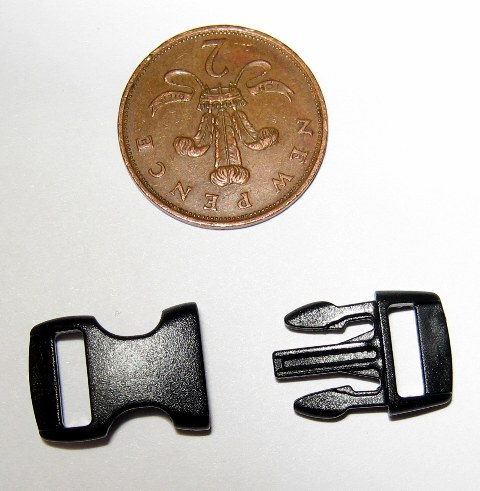The basic idea is to whip one end of the cord around the other in such a way that there’s plenty of friction to hold the ends together in normal use, but no true knot tying the ends, so it will come apart under tension. Because whipping is tied very similarly to a hangman’s noose, and because of its anti-strangulation purpose, I call it an “unhangman’s knot”.
I like gutted paracord for EDC – it’s flat and comfortable – but the pics below show regular paracord for clarity. Measurements are approximate… like most paracord projects, you need to fiddle around a bit with lengths. I start off with enough cord to make the lanyard loop, plus 20 inches or so (less for smaller diameter cordage).
Step 1: Pinch one end of the cord about 12 inches from the end (less for smaller diameter cordage). Twist the end a number of times, until it really wants to kink. Double the twisted portion back into a bight. It will naturally twist together to form a spiral.
http://www.rdwarf.com/users/mink/img/s1.jpg
Step 2: Tie off the spiraled bight with an overhand knot. The ridges formed by the spiral will give the whipping a good grip surface.
http://www.rdwarf.com/users/mink/img/s2.jpg
Step 3: With the opposite end, tie an overhand keeper knot around the spiral. Leave 8 to 10 inches of cord to work with. Pull the keeper knot tight. (The position of the keeper knot – i.e., how much cord is left on the working side of this knot – will determine the final length of the lanyard, so test this before proceeding to the next step.)
http://www.rdwarf.com/users/mink/img/s3.jpg
Step 4: Make a bight of about 2 inches with the standing portion of cord, starting just under the keeper knot. Lay the bight alongside the spiral.
http://www.rdwarf.com/users/mink/img/s4.jpg
Step 5: Whip the working end around the spiral and the bight, 6 to 8 loops, keeping the whipping snug as you go. Put the end of the cord through the remaining exposed portion of the bight.
http://www.rdwarf.com/users/mink/img/s5.jpg
Step 6: Pull on the standing portion so that the bight slips back underneath the whipping, trapping the free end. Pull snug.
http://www.rdwarf.com/users/mink/img/s6.jpg
Step 7: Dress and trim.
http://www.rdwarf.com/users/mink/img/final.jpg
[Knot shown in paracord, gutted paracord, and type 1 accessory cord
Tension needed to release can be adjusted by varying the number of loops in the whipping as well how firmly the keeper knot and whipping are tightened. Tension can be tested by sliding the whipping up and down the spiral.
With paracord, it doesn’t seem to make a big difference whether the cord is wet or dry (it separates a bit more easilty when wet), but it will be important to see if this holds true for other types of cordage.
